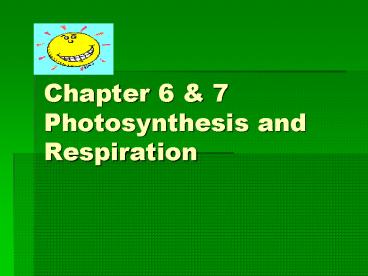Chapter 6 PowerPoint PPT Presentation
1 / 24
Title: Chapter 6
1
Chapter 6 7 Photosynthesis and Respiration
2
I. ENERGY The ability to do work
- A. Why do cells need energy?
- 1) Active Transport
- 2) Cell division, growth and development
- 3) To make macromolecules- proteins,
carbohydrates, etc. - 4) To build cell parts-extra cellular
membranes
3
- B. Two classifications of organisms based upon
how they obtain energy - 1) Autotrophs (producers) organisms that can
make their own food( glucose) example plants
4
Autotrophs
5
- 2) Heterotrophs (consumers) organisms that
obtain food from other sources example animals
and fungi
6
Heterotrophs
7
C. Pathway of Energy
- photosynthesis
cellular respiration - Sun? autotrophs ? food(glucose)?
heterotrophs? ATP
8
- D. Cellular Energy ATP Adenosine Triphosphate
- Removes phosphate
Removes phosphate - Release energy
Release energy - ATP is like a rechargeable battery
9
Overview of photosynthesis and respiration
SUN
RADIANT ENERGY
CELL ACTIVITIES
PHOTOSYNTHESIS
RESPIRATION
GLUCOSE
ATP(ENERGY)
10
E. Photosynthesis 2 RXNS
- Light-Independent Reactions
- Light-Dependent Reactions
11
II. PHOTOSYNTHESIS PHOTO light SYNTHESIS to
make
- Process by which solar energy is converted to
cellular energy (ATP) and stored food (glucose) - Overall Reaction sunlight
- 6 CO2 6 H20 ? C6H12O6 6 O2
- chlorophyll
- Occurs in the chloroplasts of plant cells
- Solar E is converted by the use of pigment,
molecules that absorb certain wavelengths of
light and reflect (what we see) others.
12
- Chlorophyll main photosynthetic pigment, absorbs
red blue light, reflects green - Accessory pigments
- Carotenes absorb blue green, reflect yellow
and orange. - In fall, chlorophyll is broken down so we see the
colors of the accessory pigments.
13
Photosynthesis consists of two phases
- 1) Light Reactions the photo part
- Solar energy converted to cellular energy (ATP)
- Chlorophyll captures (absorbs) light
- Water is split, releasing oxygen gas
- Occurs in the thylakoid membranes of the
chloroplast
14
- 2) Calvin Cycle the synthesis part
- Energy from light reactions used to fix CO2
into glucose (C6H12O6) - Occurs in the stroma of the chloroplast.
- Called Dark or light independent Reactions
15
- In hot dry conditions plants loose water through
stomata which are small pores usually located on
the undersurface of leaves - They close these to prevent water loss
16
The rate of photosynthesis is affected byLight
intensity, carbon dioxide levels, temperature
17
E. Photosynthesis 2 RXNS
- Light-Independent Reactions
- Light-Dependent Reactions
18
Link between photosynthesis and respiration
19
(No Transcript)
20
EQUATION FOR PHOTOSYNTHESIS
WATER
OXYGEN
6CO2
6H2O
ENERGY
C6H12O6
6O2
CARBON DIOXIDE
GLUCOSE
21
EQUATION FOR RESPIRATION
CARBON DIOXIDE
ATP
GLUCOSE
C6H12O6
6O2
6CO2
6H2O
ENERGY
OXYGEN
WATER
22
III. CELLULAR RESPIRATION
- A series of chemical reactions that release
energy by breaking down glucose and making H2O
and CO2. - Overall Reaction
- C6H12O6 6 O2 ? 6 CO2 6 H20
- Glucose is the primary source of energy at the
cellular level. The stored energy in its bonds
will be converted to cellular energy in the form
of ATP.
23
Cellular respirationOccurs in the
mitochondria
24
PATHWAYS OF GLYCOLYSIS RESPIRATION
- Diagram

